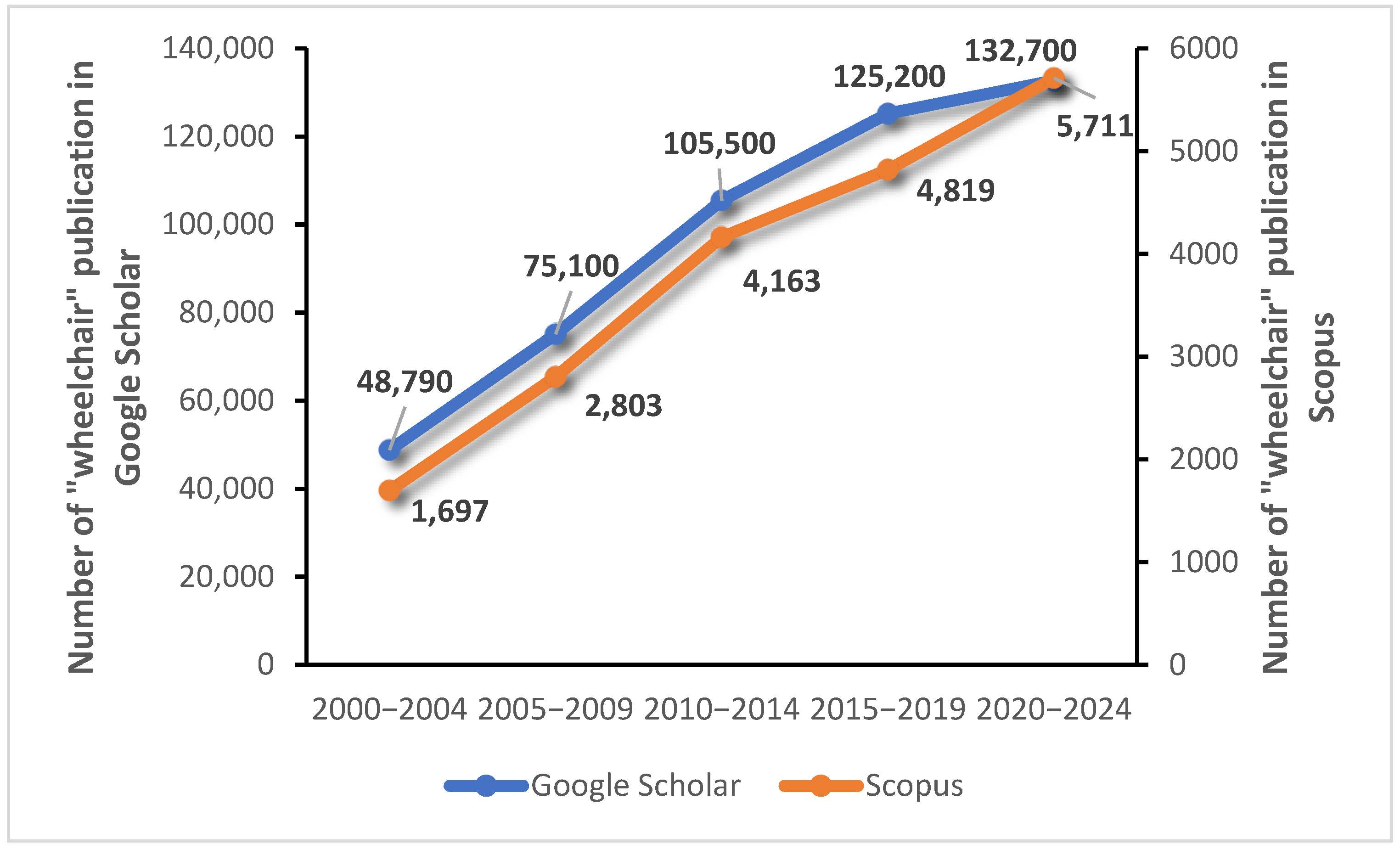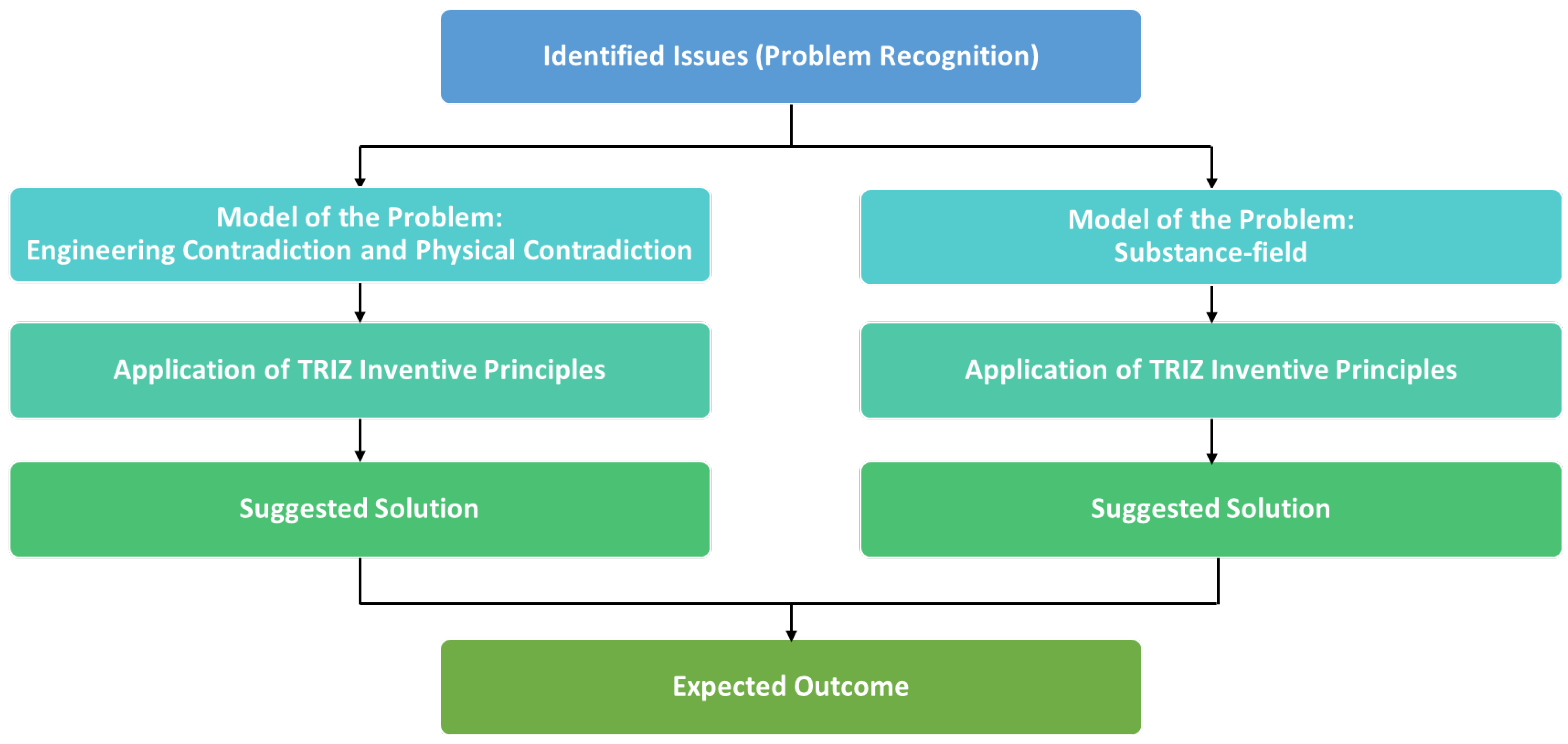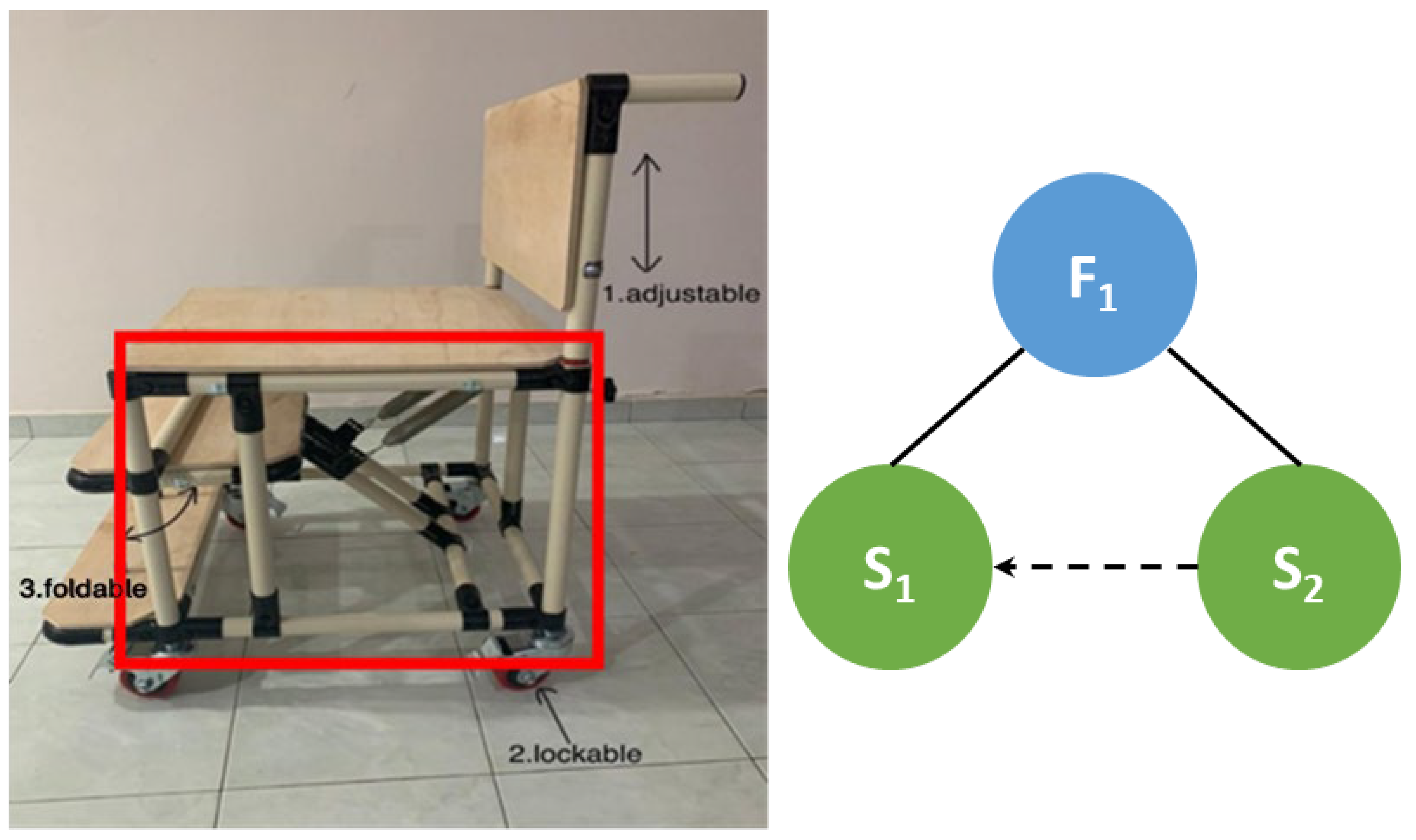1. Introduction
According to the World Health Organization, in 2010, as many as 1 billion people globally were living with disability [
1]. In 2022, this number had increased to 1.3 billion [
2]. With an increasing world population, the number of people experiencing disability is expected to increase as well. Assistive technologies, when appropriate to the person with a disability, have been shown to be powerful tools to increase independence and improve participation [
1]. An assistive technology device can be defined as “any item, piece of equipment, or product, whether it is acquired commercially, modified, or customized, that is used to increase, maintain, or improve the functional capabilities of individuals with disabilities” [
3]. For people with mobility impairments, common examples of assistive devices are crutches, prostheses, orthoses, tricycles, and wheelchairs. Among these, the wheelchair is one of the most commonly used assistive devices for enhancing personal mobility, which is a precondition for enjoying human rights and living in dignity [
4]. Accordingly, the United Nations Standard Rules (1994) and the UN Convention on the Rights of Persons with Disabilities (CRPD 2006) urge countries to support the development, production, distribution, and servicing of assistive devices such as wheelchairs, and emphasize the importance of sharing knowledge about these technologies [
4]. As such, there is a steady increase in the number of “wheelchair” publications in both Google Scholar and Scopus, as displayed in
Figure 1. This is essential especially because only a minority of those in need of wheelchairs have access to them [
5].
Among the wheelchair users, a number of them are elderly people. This is because as people age, changes in the skeletal muscles and joints [
6] led to mobility impairment in some, leading to the need for wheelchair usage. According to a study conducted on 7026 participants over the age of 65, the number of older adults who use wheelchairs had increased significantly from 4.7 per 100 people in 2011 to 7.1 in 2019 [
7]. This is also supported by Market Size and Trends that reported on the growth of the global multifunctional wheelchair market, which is primarily driven by the increasing prevalence of both mobility impairments and the rise in the geriatric population worldwide [
8].
As the global population ages and the demand for assistive technologies grows, there is a pressing need for wheelchairs that not only support basic mobility, but also address a broader range of user needs, such as comfort, ease of use, and enhanced functionality [
8]. In a reported study of evidence-based strategies for preserving mobility among elderly and aging manual wheelchair users, some of the recommendations include training, strengthening, and exercise to increase the capacity to handle daily mobility demands [
9]. It has been reported that daily walking is effective in improving the fitness level of elderly people [
10,
11,
12], making the rollator function useful for the target user. On the other hand, exercises using Pilates chairs have been concluded to improve balance, an important risk factor for falls among elderly people [
13]. Thus, wheelchairs with features such as a rollator walker and a Pilates chair add significant value to its design. Additionally, nursing homes for the elderly often has limited space [
14,
15]. Thus, designing a wheelchair with the function of a stepladder for caregivers can reduce the need to purchase multiple separate devices in nursing homes, making assistive care more accessible and affordable. Moreover, nursing staff and caregivers often experience musculoskeletal disorders (MSD) due to their work environment [
16]. Thus, according to the University of Melbourne, to prevent MSD, it is recommended for the staff to use a step stool or ladder when necessary to reach above shoulder level, or to lift objects overhead [
17]. In a limited space like nursing homes, a stepladder is therefore appropriate to prevent MSD among the caregivers.
1.1. Conceptualization, Design and Development of Multifunctional Wheelchairs in Published Research
While it is expected that the published work on specifically multifunctional wheelchairs will be less extensive than general wheelchair studies, the former still displays an increasing trend, as shown in
Figure 2. This exemplifies the growing interest among researchers in developing an enhanced multifunctional wheelchair that is better suited for its users.
Table 1 displays the summary of published work in the conceptualization, design, and development of multifunctional wheelchairs. Most of the work published reports two to three functions, including the function of a wheelchair. The work published by Gan et al. (2022) [
18] displayed the highest number of functions, including wheelchair, walker, Pilates chair, and stepladder, displaying a notable contribution to the field of multifunctional wheelchair design.
1.2. Design and Fabrication Studies of Multifunctional, Multipurpose, and Similar Inventions
Design and fabrication studies have been crucial in developing multifunctional products. As summarized in
Table 2, these studies have utilized various processes to create inventions such as a multipurpose ladder, a multifunctional lawnmower, a multipurpose table, a multifunctional stretcher, and a foldable wheelchair stretcher. While these processes are detailed, they often lack an issue- or problem-based approach, which could lead to creating a more effective invention.
1.3. TRIZ in Product Design
Originally conceptualized by Alʹtshuller (1999) [
28], TRIZ provides structured tools and techniques to eliminate trade-offs, thereby enhancing the efficiency and effectiveness of engineering solutions. Since then, numerous studies have reported on the use of TRIZ in designing and fabricating their inventions, as shown in
Table 3. While contradiction models are widely used, another important but less common tool is Su-field analysis. This method offers a different perspective on the problem compared to contradictions, by looking at the interaction among two substances and a field. This method can be particularly useful for solving problems involving systems and their components, and it may offer a different perspective than a contradictions analysis.
This study builds on the conceptual work by Gan et al. (2022) [
18] and the prototype development of a multifunctional stepladder by Selvanesan et al. (2025) [
35]. Both these previous works integrated features and functions drawn from patent literature, existing commercial products, and relevant scientific research to design and develop a multifunctional stepladder with the functions of a wheelchair, walking aid, and Pilates chair. Based on these foundational studies, the current research aims to conceptually enhance the invention using TRIZ tools, namely contradiction analysis and Su-field analysis.
The invention formerly referred to as the “Multifunctional Stepladder” has been renamed the “Multifunctional Rollator Walker” to better reflect its primary function and intended application in nursing homes. Therefore, the following research questions (RQs) are proposed to address the problem statement of this study:
RQ1: How to analyze the engineering and physical design contradictions in the conceptual enhancement of a multifunctional wheelchair and systematically resolve them using TRIZ Inventive Principles.
RQ2: How to utilize the Su-field analysis for modeling the issues in the conceptual enhancement of a multifunctional wheelchair and resolve them using TRIZ Inventive Principles.
5. Conclusions
This research has made significant effort in addressing the complex, multifaceted challenges involved in conceptually enhancing a multifunctional rollator walker through a TRIZ-based conceptual framework. By rigorously investigating and resolving two core research questions, the study offers a valuable contribution to the field of assistive technology innovation. The first research question (RQ1), concerning the analysis of engineering and physical design contradictions, was methodically clustered based on the key issues and resolved using the suitable TRIZ Inventive Principles. This process uncovered critical conflicts within traditional wheelchair designs, specifically the trade-offs between portability and durability, and between enhanced user support features and structural simplicity.
The second research question (RQ2) explored the application of the Su-field analysis for modeling the issues. The elements and interaction types were identified, and suitable classes from Standard Inventive Solutions (SIS) were selected, followed by leveraging specific TRIZ tools, such as segmentation, dynamic parts, nested doll structures, and composite materials. As a result, the method addressed the following issues of current wheels that could induce injuries, lack of armrests, difficulty in transforming the invention, and inaccessible wheels hindering maneuverability from a seated position.
The study succeeded in developing an innovative conceptual solution that eliminates the need for design compromises. These solutions were synthesized into a highly functional conceptual prototype that integrates multiple assistive features, namely, a wheelchair, stepladder, rollator walker, and Pilates chair, into a single cohesive and adaptable device.
5.1. Limitations of Study
Despite the promising outcomes, this study remains at the stage of a conceptual enhancement of a previously developed prototype. Partial fabrication has been performed; however, the invention is yet to undergo real-world testing or extensive empirical validation. User trials involving the target users, which are elderly people and caregivers, are essential to assess the practicality, reliability, and acceptability of the proposed design. Furthermore, while the current version emphasizes mechanical innovation, it does not yet incorporate powered systems or sensor-based intelligence, which are increasingly relevant in modern assistive devices. Most importantly, the current design is not suitable for individuals with advanced mobility impairments such as spinal cord injury, who require more complex modifications.
The manufacturing feasibility of the complex folding mechanisms and modular systems also warrants further investigation, especially in terms of production scalability, maintenance requirements, and cost-efficiency. Additionally, regional customization based on environmental or socio-economic factors, such as the terrain conditions of nursing homes in rural areas or affordability in low-income contexts, has not been fully addressed within this study.
5.2. Future Research
Looking forward, the study opens several promising avenues for future research. One immediate opportunity is the refinement and full-scale development of the prototype based on the conceptual enhancement, followed by structured usability testing under varied environmental and user conditions. Integrating advanced features such as sensor technology and smart systems [
44,
45], IoT-based monitoring, biometric sensors, and modular motorized assistance could further expand the functionality and appeal of the device. Moreover, coupling TRIZ with complementary design methodologies, such as Quality Function Deployment (QFD), Failure Mode and Effects Analysis (FMEA), and user co-design strategies, can strengthen the alignment between technical innovations and real-world user expectations.
In conclusion, this research not only demonstrates the application of TRIZ as a powerful tool for conceptual innovation in assistive technology design but also delivers a tangible outcome in the form of a multifunctional wheelchair prototype that addresses pressing mobility challenges. It highlights the value of contradiction-resolution thinking in transforming the limitations of conventional wheelchair design into opportunities for multi-functionality, adaptability, and enhanced user autonomy. By laying a robust foundation for further development, testing, and refinement, this study contributes a meaningful step toward the creation of next-generation mobility solutions that are safer and space-saving.

















